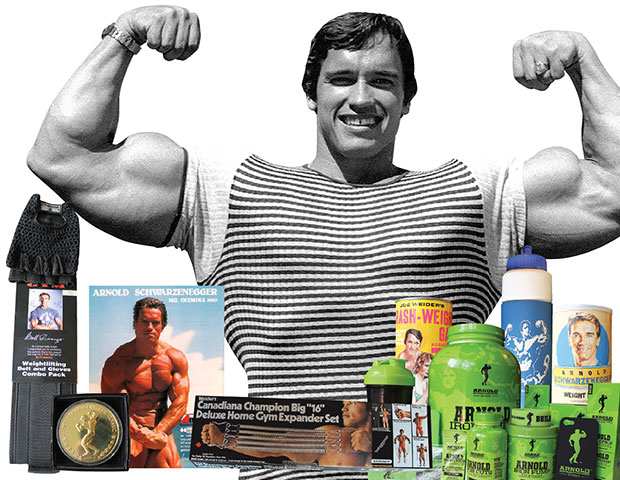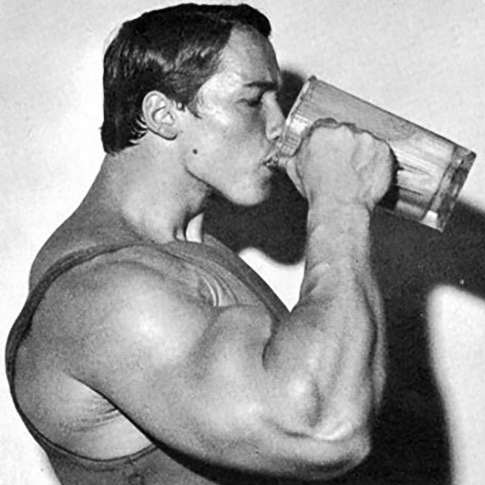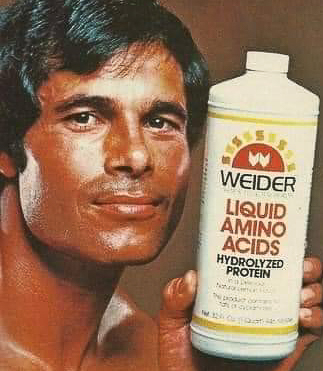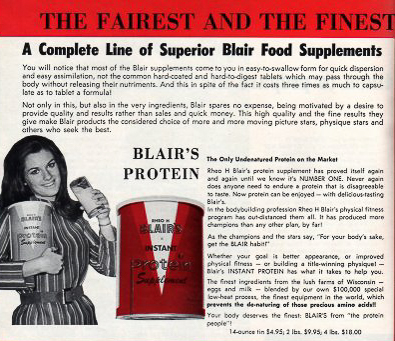Arnold-Era Nutrition and Supplements

A look back at the evolution of bodybuilding nutrition and supplements from the 1970s and ‘80s until now!
Back in the Arnold era, athletes and more specifically, bodybuilders, followed very specific nutrition and supplement regimes. The nutrition plans and supplements used back in the ‘70s and early ‘80s have many similarities, but also many differences compared to what most bodybuilders and fitness competitors would use today. Read on to learn more about the history and evolution of sports nutrition and supplement world from the golden era until now.
Arnold-Era Nutrition
 Most bodybuilders of the Arnold era (1970s–80s) generally followed a very similar nutrition plan. High-protein and moderate carbs and fats was the norm. Their diets were very similar during the “off-season” to their pre-competition diets. In fact, bodybuilders such as Arnold would consume almost the exact same foods whether bulking or while cutting. The only major change was a reduction in calories and carb intake, and cutting out the little bit of junk/fried food that they would occasionally eat.
Most bodybuilders of the Arnold era (1970s–80s) generally followed a very similar nutrition plan. High-protein and moderate carbs and fats was the norm. Their diets were very similar during the “off-season” to their pre-competition diets. In fact, bodybuilders such as Arnold would consume almost the exact same foods whether bulking or while cutting. The only major change was a reduction in calories and carb intake, and cutting out the little bit of junk/fried food that they would occasionally eat.
Proteins
Protein was the most important part of the nutrition plan back in the day and made up a large portion of the diet. The most popular protein sources were lean beef, ground beef (usually made into patties), eggs, chicken, fish, milk, and cottage cheese. Most of these foods are still very popular sources of protein nowadays, but many athletes will try and avoid much of the fat content found in these foods. For instance, in the Arnold era, most guys would always eat whole eggs (even if they were cutting), whereas nowadays many athletes will throw out the yolk and only eat the whites, in order to avoid the fat content. The same thing goes for milk. Back in the day, some bodybuilders would literally drink gallons of whole milk every day. Today, it would be tough to find any bodybuilder that regularly drinks a lot of milk, and forget about the high-fat whole milk or cream.
 Carbohydrates
Carbohydrates
Carbs weren’t considered the most important component of the diet back in the Arnold era, but they definitely weren’t overlooked. Carbs were used to fuel the intense and lengthy workouts that were much more common back in the ‘70s and ‘80s. Arnold and his comrades kept their carb intake pretty simple. The most popular carb source was potatoes, usually in the form of home fries and baked potatoes. Rice was also a staple, but usually in the white form. Whole wheat toast was also consumed on a regular basis, but more so during the off-season. Bodybuilders in the Arnold era did consume decent amounts of vegetables, but I think the importance of greens is emphasized much more today. Arnold also used to consume a decent amount of fruit (usually post-workout), and so did a lot of bodybuilders back then. You don’t see as many bodybuilders or fitness competitors consuming a lot of fruits nowadays, especially not when they’re cutting up for a competition.
Fats
The one macronutrient source and intake that has changed the most from the Arnold era is fat. In the ‘70s and ‘80s most bodybuilders consumed a moderate amount of fat, which usually came from their protein sources—for instance, fat from beef, egg yolks, milk, and cheese. Nowadays, athletes and bodybuilders are much more selective with their fat sources and usually hand-select and measure of all of their fat intake. The most popular sources of fats today come from fish (either whole fish or fish oil supplements), a variety of nuts (again, either from whole sources or from supplemental oils). The emerging research and education on essential fatty acids (EFAs), monounsaturated fats, and polyunsaturated fats has been one of the biggest advancements in nutrition since the Arnold era. The importance of getting the right amounts of mono and polyunsaturated fats is even known by people with little nutrition education at all. In the Arnold era, athletes consumed a lot more saturated fat and less monos and polys. Today, most athletes consume much less saturated fat and much more mono and polyunsaturated fats. This is a good thing, not only from a performance and physique perspective but also from a general health perspective.
Arnold-Era Supplements
 The use of supplements has dramatically changed in some ways from the ‘70s and ‘80s to now. There are a lot of basic supplements, such as aminos and protein powders, which were consumed back then and are still nowadays. But the one major difference is in the quality of these supplements.
The use of supplements has dramatically changed in some ways from the ‘70s and ‘80s to now. There are a lot of basic supplements, such as aminos and protein powders, which were consumed back then and are still nowadays. But the one major difference is in the quality of these supplements.
Protein Powders & Shakes
Back in the Arnold era, most of the protein powders were milk- and egg-based. They contained a lot more fat and lactose (milk sugar) than most protein powders consumed today. Bodybuilders in the ‘70s and ‘80s weren’t concerned about the extra fat content, the same way they weren’t concerned about the extra fat they consumed in their whole-food protein sources. The milk and egg powders that Arnold consumed back in the ‘70s didn’t taste too great and were most often very clumpy and had to be mixed up well in a blender. Nowadays, one can throw a couple of scoops of whey protein into a cup with water and mix it up perfectly with a few shakes. In the Arnold era, the guys would often blend many other ingredients into their protein shakes, such as lecithin, cream (for extra calories), juice, milk, safflower oil, and even raw whole eggs. You would be hard-pressed to find any bodybuilder today who would consume these types of shakes on a regular basis.
Desiccated Liver Tablets
Desiccated (dried) liver tablets were one of the most popular supplements back in the ‘70s and ‘80s. Bodybuilders used desiccated liver as a protein supplement because it’s high in very essential amino acids, iron, and B vitamins. Desiccated liver tablets were popular at the same time as those huge amino tablets were. Although desiccated liver tablets were really popular back in the day, athletes and bodybuilders now have access to much more effective protein and amino acid options, such as whey protein concentrates, isolates, casein and superior-quality branched-chain amino acids powders. You can still find desiccated liver in Universal Nutrition’s Animal Pak tablets, but I don’t think they’ve updated that formula too much since it launched back in 1983.
Amino Acids
 Amino acid supplements really started to gain popularity back in the ‘70s. Most of the amino acid supplements were made with free-form amino acids. Two of the most popular free-form amino supplements back in the ‘70s and ‘80s were glutamine and arginine. These two aminos are still quite popular today, glutamine for the same reasons and arginine for slightly different reasons. Even back in the ‘70s, bodybuilders were aware of glutamine’s recovery and immune-enhancing benefits. Arginine was used more of a growth hormone booster back in the Arnold era, whereas today it’s used more as a nitric oxide booster to enhance muscle pumps. The one amino acid that wasn’t available or well-recognized back in the Arnold era was creatine. It wasn’t until the early 1990s that creatine started to gain recognition as one of the greatest sports supplement revelations ever! Today, creatine is easily one of the most widely consumed performance-enhancing supplements in the world.
Amino acid supplements really started to gain popularity back in the ‘70s. Most of the amino acid supplements were made with free-form amino acids. Two of the most popular free-form amino supplements back in the ‘70s and ‘80s were glutamine and arginine. These two aminos are still quite popular today, glutamine for the same reasons and arginine for slightly different reasons. Even back in the ‘70s, bodybuilders were aware of glutamine’s recovery and immune-enhancing benefits. Arginine was used more of a growth hormone booster back in the Arnold era, whereas today it’s used more as a nitric oxide booster to enhance muscle pumps. The one amino acid that wasn’t available or well-recognized back in the Arnold era was creatine. It wasn’t until the early 1990s that creatine started to gain recognition as one of the greatest sports supplement revelations ever! Today, creatine is easily one of the most widely consumed performance-enhancing supplements in the world.
Multivitamin/Mineral Supplements
Basic multivitamin/mineral supplements were used by many bodybuilders back in the day. They main difference nowadays is that dosages are much more specific to the needs of the targeted consumer and the quality and types of vitamins and minerals are much greater and therefore their bioavailability and benefits are much greater.
When you step back and take a look at the nutrition and supplement regimes used in the ‘70s and ‘80s versus today, there are a lot of similarities. Today, we have a lot more research available at our disposal, and it’s the scientific advancements that have really shaped the sports nutrition and supplement world as we know it now. But just like any stream of science and education, we can never forget to look back and learn from the past in order to effectively advance into the future!
Supplement Industry Pioneer – Rheo H. Blair (1921–1983)
 Rheo H. Blair was a pioneer in the nutrition and supplement industry. He was a nutritionist to major Hollywood stars and many bodybuilders too. Blair was one of the first people to bring protein and other supplements to market. His flagship product was called Blair Protein, which included the following ingredient list: calcium and sodium caseinate (milk protein) low-heat nonfat dry milk, lactalbumin, dried whole eggs, iron phosphate, natural vanilla flavour.
Rheo H. Blair was a pioneer in the nutrition and supplement industry. He was a nutritionist to major Hollywood stars and many bodybuilders too. Blair was one of the first people to bring protein and other supplements to market. His flagship product was called Blair Protein, which included the following ingredient list: calcium and sodium caseinate (milk protein) low-heat nonfat dry milk, lactalbumin, dried whole eggs, iron phosphate, natural vanilla flavour.
 *Images Courtesy Of Instagram
*Images Courtesy Of Instagram

